On this, the holiest day of the entire year, and for the entire Octave of Easter, Latin Catholics greet each other with the words of Luke 24:34, "Surrexit Dominus vere, alleluia!" ("The Lord is risen indeed!"). The person so greeted responds, "Et apparuit Simoni, alleluia!" ("And hath appeared unto Simon!"). Catholics may even answer their telephones with this greeting. An old Ukrainian legend relates that, after His Resurrection, Christ threw Satan into a deep pit, chaining him with twelve iron chains. When Satan has chewed through each of the twelve chains, the end of the world will come. All year long, the Evil One gnaws at the iron, getting to the last link in the last chain -- but too late, for it is Easter, and when the people cry "Christ is risen!" all of Satan's efforts are reversed. When the faithful stop saying the Easter acclamation, the end of time has come...
Throughout the entire Easter Season, the Angelus prayer that is offered, when possible, at the ringing of the Angelus bells, is replaced by the joyous Regina Coeli, which begins, "Queen of Heaven rejoice, alleluia: For He whom you merited to bear, alleluia, Has risen as He said, alleluia."
On this most beautiful of Feasts, the Easter table should be adorned with the best of everything -- the most beautiful china, a pure, white tablecloth, the best possible wine, flowers (especially pussy willow, lilies, and spring bulb flowers), etc., all with the colors white and gold -- symbolizing purity and glory -- and the traditional symbols of Easter predominating. And we should look our best, too; it is common for those who can afford it to buy a new outfit to wear on this day. This custom springs from the idea of "newness" inherent in the entire Season -- the new members of the Church baptized at the Vigil in their new Baptismal albs, the New Law, a new life in Christ.
The Paschal Candle representing the Light of Christ (Lumen Christi) is the centerpiece of the table today and, like the Paschal Candle at church, is relit each day (such as at dinner and during family prayer) until the Feast of the Ascension in 40 days when the Light of the World leaves us to ascend to His Father. The candle should be large and white, and should be surrounded with flowers and the symbols of Easter. It can be carved with the Cross and the numbers for the current year as the church's Paschal Candle was yesterday -- first the Cross, then the Greek letters, then the numbers of the current year as in the diagram below. The cuts can be painted to make them stand out (try gold or deep red paint), and 5 grains of incense can be inserted at the ends and center of the Cross to symbolize the 5 Wounds(some people use cloves in place of incense at home, but if you have 5 grains of incense blessed on the Feast of the Epiphany, all the better) . The words to pray when making the cuts:
Throughout the entire Easter Season, the Angelus prayer that is offered, when possible, at the ringing of the Angelus bells, is replaced by the joyous Regina Coeli, which begins, "Queen of Heaven rejoice, alleluia: For He whom you merited to bear, alleluia, Has risen as He said, alleluia."
On this most beautiful of Feasts, the Easter table should be adorned with the best of everything -- the most beautiful china, a pure, white tablecloth, the best possible wine, flowers (especially pussy willow, lilies, and spring bulb flowers), etc., all with the colors white and gold -- symbolizing purity and glory -- and the traditional symbols of Easter predominating. And we should look our best, too; it is common for those who can afford it to buy a new outfit to wear on this day. This custom springs from the idea of "newness" inherent in the entire Season -- the new members of the Church baptized at the Vigil in their new Baptismal albs, the New Law, a new life in Christ.
The Paschal Candle representing the Light of Christ (Lumen Christi) is the centerpiece of the table today and, like the Paschal Candle at church, is relit each day (such as at dinner and during family prayer) until the Feast of the Ascension in 40 days when the Light of the World leaves us to ascend to His Father. The candle should be large and white, and should be surrounded with flowers and the symbols of Easter. It can be carved with the Cross and the numbers for the current year as the church's Paschal Candle was yesterday -- first the Cross, then the Greek letters, then the numbers of the current year as in the diagram below. The cuts can be painted to make them stand out (try gold or deep red paint), and 5 grains of incense can be inserted at the ends and center of the Cross to symbolize the 5 Wounds(some people use cloves in place of incense at home, but if you have 5 grains of incense blessed on the Feast of the Epiphany, all the better) . The words to pray when making the cuts:
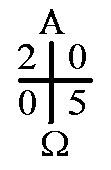
While cutting the vertical branch of the Cross: | |
Christus heri et hódie | Christ yesterday and today. |
While cutting the horizontal branch of the Cross: | |
Princípium et Finis, | the Beginning and the End, |
While cutting the Greek letters: | |
Alpha et Omega. | Alpha and Omega. |
While cutting the millenial figure of the year at the upper left quadrant: | |
Ipsíus sunt témpora | His are the times |
While cutting the second figure of the year in the upper right quadrant: | |
et sæcula. | and ages. |
When cutting the decade figure of the year in the lower left quadrant: | |
Ipsi glória et impérium | To Him be glory and dominion |
When cutting the last figure of the year in the lower right quadrant: | |
per univérsa æternitátis sæcula. Amen. | through all ages of eternity. Amen |
When inserting incense for the First Wound: | |
Per sua sancta vúlnera | By His holy |
When inserting incense for the Second Wound: | |
gloriósa | and glorious wounds |
When inserting incense for the Third Wound: | |
custódiat | may He guard |
When inserting incense for the Fourth Wound: | |
et consérvet nos | and preserve us, |
When inserting incense for the Fifth Wound: | |
Christus Dóminus. Amen. | Christ the Lord. Amen. |
As the candle is lit: | |
Lumen Christi glorióse resurgéntis díssipet ténebras cordis et mentis. | May the light of Christ in glory rising again dispel the darkness of heart and mind. |
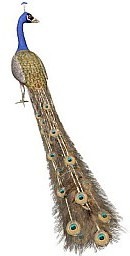
It was once believed that the flesh of the peacock never corrupts, so peacocks became the classic symbol of immortality. They are an ancient Christian symbol of the Resurrection, and representations of them are found on the tombs of ancient Christians as an expression of their hope to follow Christ in His defeat of death.
Bells are another lovely symbol for the day as they are said to have gone to Rome on Maundy Thursday only to have started returning home at last evening's Easter Vigil to ring joyfully (in France and Belgium, it is these bells, not the Easter bunny, that bring the Easter eggs -- see below).
In the United States, the most common symbol of that glorious resurrection for the entire Easter Season is the lily (lilium longiflorum). Jesus loved lilies!:
 | Luke 12:27 Consider the lilies, how they grow: they labour not, neither do they spin. But I say to you, not even Solomon in all his glory was clothed like one of these. |
 Butterflies, too, are an apt symbol of the day's meaning. Beginning life as lowly humble caterpillars, they "entomb" themselves in cocoons only to emerge with jewel-colored wings and the ability to soar. What better symbol of the Resurrection -- except maybe for eggs, which had always been symbols of Spring and were items of wonderment to all -- an inanimate object out of which comes life. For Christians, they became the perfect symbol of the tomb Christ conquered, and Jews used (and used) them on their Passover, too, as the Haggadot specifically calls for it as a symbol of rebirth (this is a rabbinical command, not a Scriptural one).
Butterflies, too, are an apt symbol of the day's meaning. Beginning life as lowly humble caterpillars, they "entomb" themselves in cocoons only to emerge with jewel-colored wings and the ability to soar. What better symbol of the Resurrection -- except maybe for eggs, which had always been symbols of Spring and were items of wonderment to all -- an inanimate object out of which comes life. For Christians, they became the perfect symbol of the tomb Christ conquered, and Jews used (and used) them on their Passover, too, as the Haggadot specifically calls for it as a symbol of rebirth (this is a rabbinical command, not a Scriptural one).Another level of symbolism is that the egg represents birth, the Creation, the elements, and the world itself, with the shell representing the firmament, the vault of the sky where the fiery stars lie; the thin membrane symbolizing air; the white symbolizing the waters; and the yolk representing earth. Painted red, eggs are a demonstration that the salvation and re-birth of the world comes through Christ's Blood and Resurrection. Old legend has it that St. Mary Magdalen went to Rome and met with the Emperor Tiberius to tell him about the Resurrection of Jesus. She held out an egg to him as a symbol of this, and he scoffed, saying that a man could no more rise from the dead than that egg that she held could turn scarlet. The egg turned deep red in her hands, and this is the origin of Easter eggs, and the reason why Mary Magdalen is often portrayed holding a scarlet egg.

Because of this legend and all of the egg's symbolism, and because eggs are special because they were once forbidden during Lent, Christians make great use of them on this day, eating them, decorating them, and decorating with them. Red is the classic color to use when dying eggs to be eaten, but other colors are more often used these days (pastels being the most 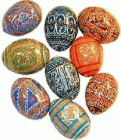 common in the United States). Eggs used only for decorative purposes may have their contents blown out and their shells turned into highly ornamental works of art ("Longshanks" -- King Edward I of England, 1239-1307 -- paid to have 450 eggs decorated with gold leaf to give out to the members of his household). Or the "eggs" may be wooden or ceramic and used to adorn the Easter table. The exquisite pysanky of Eastern Europe, made by subsequent applications of wax and dipping in dyes, are one of Easter's treasures, and the forty-nine ceramic, bejewelled eggs created -- only one or two each year at Eastertime -- for the Russian royal family by master jeweller, Peter Carl Fabergé (1846-1920), are museum pieces.
common in the United States). Eggs used only for decorative purposes may have their contents blown out and their shells turned into highly ornamental works of art ("Longshanks" -- King Edward I of England, 1239-1307 -- paid to have 450 eggs decorated with gold leaf to give out to the members of his household). Or the "eggs" may be wooden or ceramic and used to adorn the Easter table. The exquisite pysanky of Eastern Europe, made by subsequent applications of wax and dipping in dyes, are one of Easter's treasures, and the forty-nine ceramic, bejewelled eggs created -- only one or two each year at Eastertime -- for the Russian royal family by master jeweller, Peter Carl Fabergé (1846-1920), are museum pieces.
Easter eggs that are to be eaten may be blessed by the priest (sometimes on Holy Saturday with the rest of the Easter foods brought to church in a basket, or sometimes after the liturgy today) with the following blessing from the Roman Ritual:
 common in the United States). Eggs used only for decorative purposes may have their contents blown out and their shells turned into highly ornamental works of art ("Longshanks" -- King Edward I of England, 1239-1307 -- paid to have 450 eggs decorated with gold leaf to give out to the members of his household). Or the "eggs" may be wooden or ceramic and used to adorn the Easter table. The exquisite pysanky of Eastern Europe, made by subsequent applications of wax and dipping in dyes, are one of Easter's treasures, and the forty-nine ceramic, bejewelled eggs created -- only one or two each year at Eastertime -- for the Russian royal family by master jeweller, Peter Carl Fabergé (1846-1920), are museum pieces.
common in the United States). Eggs used only for decorative purposes may have their contents blown out and their shells turned into highly ornamental works of art ("Longshanks" -- King Edward I of England, 1239-1307 -- paid to have 450 eggs decorated with gold leaf to give out to the members of his household). Or the "eggs" may be wooden or ceramic and used to adorn the Easter table. The exquisite pysanky of Eastern Europe, made by subsequent applications of wax and dipping in dyes, are one of Easter's treasures, and the forty-nine ceramic, bejewelled eggs created -- only one or two each year at Eastertime -- for the Russian royal family by master jeweller, Peter Carl Fabergé (1846-1920), are museum pieces. Easter eggs that are to be eaten may be blessed by the priest (sometimes on Holy Saturday with the rest of the Easter foods brought to church in a basket, or sometimes after the liturgy today) with the following blessing from the Roman Ritual:
| P: Adjutorium nostrum in nomine Domini | P. Our help is in the Name of the Lord | |
| R: Qui fecit caelum et terra. | R. Who made Heaven and earth | |
| P: Dominus vobiscum. | P. The Lord be with you. | |
| R: Et cum spiritu tuo. | R. And with thy spirit. | |
Subveniat, quaesumus Domine, tuae benedictionis + gratia, huic Ovorum creaturae: ut cibus salubris fiat fidelibus tuis, in tuarum gratiarum actione sumentibus, ob resurrectionem Domini nostri Jesu Christi, qui tecum vivit et regnat in saecula saeculorum. Amen. | May the grace of Thy blessing, we beseech Thee, O Lord, + come upon these eggs, that they may become a wholesome food for Thy faithful, who gratefully receive them in honor of the Resurrection of our Lord Jesus Christ, who liveth and reigneth unto endless ages. Amen. |
There is yet another tradition involving Easter eggs: at the dinner table, each family member has his own egg. The first person turns to the person next to him and they strike their eggs against each other. When hitting the eggs together, the eggs can only touch rounded end to rounded end; they can't make contact from the side. The person whose egg cracks, which symbolizes the breaking open of Christ's tomb, yells the Easter greeting mentioned above, "Surrexit Dominus vere, alleluia!" ("The Lord is risen indeed!"). The person with the intact egg responds, "Et apparuit Simoni, alleluia!" ("And hath appeared unto Simon!") and then goes to the next person and repeats the egg smashing. And so it goes around the table, with the survivor of each round turning to the next person in line and trying to crack his next opponent's egg. If your egg cracks, you're out. The person who remains at the end with the intact egg will be blessed for the year.
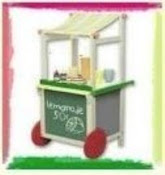








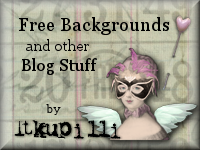


3 comments:
Blessings and best wishes to you at this beautiful time of year.
Happy Easter!
Natasha.
Wishing you a blessed Easter.
Thank you for sharing such beautiful information. I did not know why Mary Magdelene often appeared in paintings with a red egg. Blessings to you and yours!
Post a Comment
Thanks for your comments! Your thoughts are valuable to me. I hope you enjoyed my blog site. Come again.